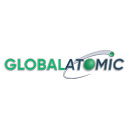US Reinstates Uranium as a Critical Mineral & Why This Resets the Investment Outlook for Nuclear Fuel

US reinstates uranium as critical mineral, accelerating domestic production through FAST-41 permitting. Energy Fuels, enCore Energy lead supply chain rebuild.
- The US has reinstated uranium to the 2025 Critical Minerals List, reshaping permitting, capital allocation, and domestic supply priorities.
- The shift directly responds to strategic supply vulnerabilities while global supply chains face sustained geopolitical pressure.
- Federal programs such as FAST-41 and targeted grants accelerate development timelines for domestic producers.
- Companies with US-based production or conversion capabilities, such as Energy Fuels and enCore Energy stand to benefit from a structurally improved policy environment.
- Exploration and development companies including ATHA Energy, IsoEnergy, and Global Atomic gain leverage as uranium tightens globally.
A Structural Policy Shift: Why the US Returned Uranium to the Critical Minerals List
The United States Geological Survey's decision to return uranium to the 2025 Critical Minerals List represents a fundamental recalibration of energy security priorities. After removing uranium from the list in 2022, the administration's reversal signals recognition that nuclear fuel supply chains require the same strategic protection accorded to rare earth elements, lithium, and cobalt. The designation carries tangible regulatory, financial, and diplomatic weight designed to reduce American dependence on foreign uranium suppliers.
Uranium serves dual functions within the US energy architecture. Commercial nuclear power plants generate approximately 18% of domestic electricity, while naval reactors power the submarine and aircraft carrier fleet. Both applications depend on uranium supply chains dominated by state-controlled producers in Kazakhstan, Russia, and China, exposing both civilian utilities and defense contractors to geopolitical volatility. Russia has provided approximately 25% of US uranium supply in recent years, prompting current import restrictions.
The White House, State Department, and federal agencies have elevated uranium to strategic priority status, recognizing projects that address supply vulnerabilities as nationally significant. Stephen Roman, President and Chief Executive Officer of Global Atomic Corporation, describes the administration's policy evolution:
"I would say since the Trump administration has come in there's been a complete change of attitude in the United States. I think they've declared uranium as a critical mineral. They've declared uranium as a critical mineral. The administration right up to Secretary of State Marco Rubio knows about our project. It has been basically blessed by the White House, the State Department, and various others in the administration."
The policy shift aligns with broader diplomatic initiatives aimed at securing uranium access from Central Asia. The critical mineral designation provides the regulatory and financial architecture to rebuild domestic production capacity across mining, milling, conversion, and fuel fabrication. The strategic imperative extends beyond civilian energy security to encompass defense applications, where vertical integration of critical mineral supply chains offers competitive advantages that transcend single-commodity exposure.
The White Mesa Mill in Utah represents the intersection of uranium production and rare earth element processing, demonstrating how infrastructure built for nuclear fuel can serve multiple strategic mineral supply chains simultaneously. Mark Chalmers, President and Chief Executive Officer of Energy Fuels, frames this convergence:
"Energy Fuels is a company that is unique from all others that you'd look at because we are focused on building a critical mineral hub that is built around our uranium business but also includes the rare earth suite of elements."
How Critical Mineral Status Reshapes Project Timelines & Capital Allocation
Projects now qualify for FAST-41 review, a federal framework that consolidates multi-agency permitting and imposes binding deadlines. For uranium developers navigating overlapping federal, state, and tribal jurisdictions, FAST-41 eligibility can compress timelines by two to four years, materially improving internal rate of return and net present value calculations.
FAST-41 designation prioritizes uranium projects within the federal permitting queue, ensuring coordinated review from the Environmental Protection Agency, Bureau of Land Management, Nuclear Regulatory Commission, and Army Corps of Engineers. This eliminates sequential review bottlenecks that historically stretched permitting beyond economic viability. Beyond permitting acceleration, critical mineral status opens access to federal capital programs including low-interest loans, tax incentives, and direct grants.
The transformation from multi-year regulatory uncertainty to predictable permitting windows fundamentally alters project risk profiles and capital allocation decisions. Companies with assets already positioned within the FAST-41 framework gain immediate advantages in financing negotiations and utility contracting discussions. William Sheriff, Executive Chairman of enCore Energy, quantifies the regulatory shift's dual impact on the project in South Dakota:
"Our South Dakota project got FAST-41 designated by the federal government which was a welcome sign… It gives you a much more certain and much more acceptable timeline to get through all of your filing… You cut your timelines dramatically, you increase your certainty."
Impact on Domestic Supply Chains: Mining, Milling, Conversion & Fuel Cycle Gaps

The United States faces structural imbalances across the uranium fuel cycle. Domestic mining capacity remains constrained, with in-situ recovery operations in Texas, Wyoming, and South Dakota representing the majority of near-term production potential. Milling capacity represents an acute bottleneck, with the White Mesa Mill in Utah operating as the only conventional uranium mill currently processing in the United States.
The facility has licensed capacity to produce over eight million pounds of uranium oxide annually and produced approximately 150,000 pounds in the first quarter of 2025. Energy Fuels expects 2025 production of 700,000 to one million pounds. The company achieved commercial-scale neodymium-praseodymium production in 2024, with Phase 1 capacity to process up to 10,000 tonnes annually of monazite and produce up to 1,000 tonnes annually of neodymium-praseodymium oxide. The company controls nearly 70 million pounds of combined uranium resources.
Washington's objective of reducing dependence on Chinese rare earth supply and Russian nuclear fuel services requires operational infrastructure capable of processing multiple critical mineral streams. The convergence of uranium milling and rare earth extraction at a single permitted facility addresses strategic vulnerabilities across two supply chains simultaneously. Mark Chalmers articulates this dual-purpose capability:
"If the United States wants to reshore the ability to be independent of China particularly on rare earth or reduce dependency on Russia, we have a facility in the United States that's constructed, permitted, operating to do that."
Conversion and enrichment capacity represents the most severe supply chain constraint. The US currently lacks domestic uranium conversion capacity, relying on facilities in Canada, France, and historically Russia. This gap creates vulnerabilities that mining expansion cannot address without parallel investment in downstream infrastructure. Uranium Energy Corp is advancing plans for the US Uranium Refining & Conversion Corporation, a proposed facility designed to restore domestic conversion capacity and align with federal priorities to eliminate Russian dependencies across the nuclear fuel cycle.
The Geopolitical Context: Competition for Influence in Kazakhstan, Central Asia & Africa
Kazakhstan supplies approximately 28% of global uranium production according to World Nuclear Association 2024 data. The United States competes with Russia and China for influence in Astana, with each power seeking preferential access through diplomatic engagement, infrastructure investment, and technical cooperation. Washington's diplomatic efforts reflect recognition that Kazakhstan's production dominance creates strategic leverage requiring diversified supply relationships.
African uranium production faces distinct challenges rooted in political instability and shifting diplomatic alignments. Niger's uranium sector historically supplied French utilities, but political developments in 2023 have introduced complexity. Russian engagement in West Africa has increased, creating supply uncertainty and geopolitical risk in project timelines.
Supply tightness manifests not only through production deficits but through logistical constraints and jurisdictional disruptions that compound delivery uncertainty. Physical uranium availability increasingly diverges from theoretical production capacity as geopolitical friction introduces friction into global supply chains.
Global Atomic is advancing the Dasa Project in Niger, containing measured and indicated resources of 12.6 million tonnes at 4,201 parts per million uranium oxide, with reserve grade of 4,113 parts per million. The company maintains government support and is targeting first production in the first quarter of 2027.
IsoEnergy's diversified asset base across Canada, the United States, and Australia provides jurisdictional balance. The Hurricane deposit features indicated resources of 48.6 million pounds at 34.5% grade, positioning it among the world's highest-grade undeveloped deposits. The mineral resource estimate is effective July 8, 2022, under National Instrument 43-101 standards. Canada's regulatory stability and transparent permitting reduce development risk compared to jurisdictions facing political uncertainty.
Nuclear fuel security ultimately depends on securing uranium feedstock before addressing downstream conversion and enrichment bottlenecks. Utilities cannot contract for enriched uranium products without confidence in primary supply availability, making exploration and mining the foundation upon which the entire fuel cycle depends. Philip Williams, Director and Chief Executive Officer of IsoEnergy, establishes this supply chain hierarchy:
"You can have all the conversion capacity in the world, all the enrichment capacity in the world, all the nuclear plants being coming online or being planned to be built, but if you don't have the fuel at the beginning then it's all irrelevant."
How Domestic Producers Benefit: Lower Timeline Risk, Higher Optionality & Improved Economics
US-focused producers benefit from policy support, jurisdictional stability, and operational advantages inherent to domestic ISR projects. In-situ recovery technology eliminates conventional mining needs, reducing capital intensity and lowering all-in sustaining costs. The environmental footprint remains smaller due to absent tailings facilities. Shorter permitting timelines directly enhance project economics by reducing time to revenue and limiting exposure to cost inflation. A two-year reduction in permitting can improve internal rate of return by 200 to 300 basis points.
Security-premium pricing represents an additional benefit as US utilities increasingly value supply agreements with American producers. The competitive advantage of operating multiple processing facilities within a single jurisdiction creates production optionality and operational redundancy that reduces execution risk.
The company's Rosita and Alta Mesa facilities in Texas provide production flexibility. Uranium processing commenced at Rosita in 2023 and at Alta Mesa in the second quarter of 2024. Both facilities are currently processing uranium, producing yellowcake. enCore Energy is the largest ISR uranium extractor in the United States, expanding wellfield infrastructure across Texas assets with four drill rigs at Rosita and exploration drilling at Tacubaya that began mid-October 2025. The Tacubaya Project was acquired using proceeds from enCore's $115 million convertible note financing at 5.5%, and provides feedstock for the Alta Mesa plant.
Operational track records with federal regulators translate directly into improved permitting outcomes and access to capital markets at competitive rates. Companies demonstrating execution capability reduce counterparty risk for utilities negotiating long-term contracts and lenders evaluating project finance structures. William Sheriff, Executive Chairman of enCore Energy, connects regulatory credibility to financial market access:
"It gives us credibility as well with the federal regulators. Going back to the FAST-41 again, going back to our permitting in Texas, we're established, we have a track record and that gives them some certainty of counterparty reliability."
Energy Fuels maintains substantial uranium resources and benefits from White Mesa Mill's strategic position. The company's rare earth diversification creates revenue optionality and balance sheet strength, providing flexibility to optimize uranium production timing.
Exploration & Development Leverage: Why the Policy Shift Extends Beyond US Borders
Critical mineral designation tightens global uranium supply by accelerating US production and diverting capital toward domestic projects, creating spillover effects benefiting high-quality exploration assets in allied jurisdictions. Canada's Athabasca Basin contains the world's highest-grade uranium deposits, with ore grades frequently exceeding 10% uranium oxide compared to global averages below 0.1%.
The current uranium cycle differs from previous price spikes in both demand durability and supply-side constraints. Sentiment-driven speculation has given way to fundamental supply deficits driven by reactor construction, life extensions, and inventory rebuilding occurring simultaneously with production shortfalls and jurisdictional disruptions. Troy Boisjoli, Chief Executive Officer of ATHA Energy characterizes the structural market setup:
"The macro environment in the uranium sector is unequivocally unlike any time I've seen in my career. The sentiment, the real demand that's being built up coupled with some of the supply side risk is a structural setup like we have not seen in the uranium space."
ATHA Energy controls the largest exploration land package in Canada exceeding seven million acres, with 3.8 million acres in the Athabasca Basin. The company also holds a 10% carried interest on key parts of NexGen and IsoEnergy land. ATHA Energy initiated a 10,000-meter drilling program in summer 2025. Results from 2024 exploration on Angilak released in October 2025 showed uranium mineralization beyond existing resource models, with high-grade intercepts including 13.6 meters averaging 4,824 counts per second.
District-scale land control in premier uranium basins provides optionality across multiple exploration targets while concentrating geological knowledge and infrastructure investment within a single operating area. Troy Boisjoli describes the strategic value of consolidated land positions:
"We're in sole control of an entire uraniferous basin here… We're in control of a district that puts us in a very good position of strength relative to the market and relative to our strategic opportunities."
Production execution risk has emerged as a critical differentiator between development-stage projects and operating mines. Industry-wide delays and cost overruns have increased investor skepticism toward aggressive production timelines, creating valuation premiums for companies demonstrating operational discipline and realistic scheduling. Philip Williams, Director and Chief Executive Officer of IsoEnergy, identifies execution failure as a recurring pattern reshaping investment criteria:
"Time and time again companies aren't able to deliver… The actual real price of getting that marginal pound of production out of the ground is much higher than anyone thinks… All of these misses that we're seeing has reinforced the strategy of let's only move ahead into production when the time is right and when we're ready."
Risk Factors & Constraints: What Investors Should Monitor
Regulatory policy remains subject to political cycles that may alter federal priorities under different administrations. Environmental permitting challenges persist despite FAST-41 designation, particularly regarding water use, groundwater protection, and Indigenous consultation. State-level agencies retain authority over water rights, creating additional approval requirements beyond federal frameworks.
Conversion and enrichment capacity represent the most significant constraints. Until conversion bottlenecks are addressed, domestic mining expansion provides only partial supply chain security. Jurisdictional risk remains material for companies operating in African jurisdictions where political developments can disrupt operations. Inflationary pressure on labor, drilling consumables, and processing reagents affects cost assumptions and margin profiles. Cost overruns and schedule delays have become more frequent, reinforcing the importance of operational track records and execution capabilities.
The Investment Thesis for Uranium
- Structural policy tailwinds from critical mineral designation accelerate permitting timelines and unlock federal capital support that improves project economics across US uranium developers and producers.
- Supply chain reorientation toward domestic production reduces strategic vulnerabilities while creating investment opportunities in companies controlling US-based mining, milling, and conversion infrastructure.
- Improved developer economics resulting from shorter regulatory timelines strengthen internal rate of return and net present value across US projects, enhancing returns on invested capital and reducing timeline risk.
- Producers with existing US infrastructure including Energy Fuels and enCore Energy have immediate operational leverage to policy support and strengthening market fundamentals.
- Exploration optionality increases for high-grade assets as ATHA Energy and IsoEnergy gain torque from tightening supply and capital rotation into uranium discovery and resource expansion.
- Geopolitical diversification needs stemming from political developments and Central Asian supply uncertainty underscore premium valuations commanded by North American projects in Tier-1 mining jurisdictions.
- Conversion capacity expansion through proposed facilities addresses acute supply chain bottlenecks and creates potential vertical integration value across the fuel cycle.
A New Policy Era Resets the Uranium Investment Landscape
The United States' reinstatement of uranium as a critical mineral represents a structural policy pivot aimed at reshoring nuclear fuel capabilities and reducing strategic dependence on foreign suppliers. Domestic producers gain immediate benefits through expedited permitting, federal capital access, and enhanced strategic relevance. High-grade exploration assets and diversified developers similarly benefit from capital rotation into uranium as utilities recognize supply constraints. For investors, the combination of geopolitical tension, tightening supply chains, and policy alignment marks a durable inflection point that extends beyond cyclical price movements into structural supply-demand rebalancing. Critical mineral designation provides the regulatory architecture, but execution remains the differentiating factor that separates successful investments from missed targets and cost overruns.
TL;DR
The US has returned uranium to the 2025 Critical Minerals List, fundamentally reshaping the investment landscape for nuclear fuel. The designation unlocks FAST-41 expedited permitting that can compress project timelines by two to four years, while federal financing programs support domestic production capacity. The policy responds to a severe supply deficit where US utilities consume 50 million pounds annually but domestic production reaches only four to five million pounds when fully ramped. Companies with operational US infrastructure including Energy Fuels and enCore Energy gain immediate advantages, while exploration firms like ATHA Energy and IsoEnergy benefit from capital rotation into high-grade uranium discovery. Global Atomic secures strategic positioning through Development Finance Corporation support and US utility offtake contracts targeting 90% of production. The critical mineral status creates durable investment opportunities across mining, milling, conversion, and exploration as geopolitical tensions and supply chain vulnerabilities drive structural rebalancing in uranium markets.
FAQs (AI-Generated)
Analyst's Notes




Subscribe to Our Channel
Stay Informed
















































